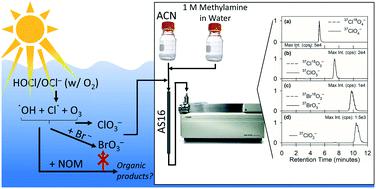当前位置:
X-MOL 学术
›
Environ. Sci.: Water Res. Technol.
›
论文详情
Our official English website, www.x-mol.net, welcomes your
feedback! (Note: you will need to create a separate account there.)
Rapid, high-sensitivity analysis of oxyhalides by non-suppressed ion chromatography-electrospray ionization-mass spectrometry: application to ClO4−, ClO3−, ClO2−, and BrO3− quantification during sunlight/chlorine advanced oxidation
Environmental Science: Water Research & Technology ( IF 3.5 ) Pub Date : 2020-07-08 , DOI: 10.1039/d0ew00429d Tessora R. Young 1, 2, 3, 4 , Shi Cheng 5, 6, 7, 8, 9 , Wentao Li 5, 6, 7, 8, 9 , Michael C. Dodd 1, 2, 3, 4
Environmental Science: Water Research & Technology ( IF 3.5 ) Pub Date : 2020-07-08 , DOI: 10.1039/d0ew00429d Tessora R. Young 1, 2, 3, 4 , Shi Cheng 5, 6, 7, 8, 9 , Wentao Li 5, 6, 7, 8, 9 , Michael C. Dodd 1, 2, 3, 4
Affiliation

|
A rapid and sensitive method is described for measuring perchlorate (ClO4−), chlorate (ClO3−), chlorite (ClO2−), bromate (BrO3−), and iodate (IO3−) ions in natural and treated waters using non-suppressed ion chromatography with electrospray ionization and tandem mass spectrometry (NS-IC-MS/MS). Major benefits of the NS-IC-MS/MS method include a short analysis time (12 minutes), low limits of quantification for BrO3− (0.10 μg L−1), ClO4− (0.06 μg L−1), ClO3− (0.80 μg L−1), and ClO2− (0.40 μg L−1), and compatibility with conventional LC-MS/MS instrumentation. Chromatographic separations were generally performed under isocratic conditions with a Thermo Scientific Dionex AS16 column, using a mobile phase of 20% 1 M aqueous methylamine and 80% acetonitrile. The isocratic method can also be optimized for IO3− analysis by including a gradient from the isocratic mobile phase to 100% 1 M aqueous methylamine. Four common anions (Cl−, Br−, SO42−, and HCO3−/CO32−), a natural organic matter isolate (Suwannee River NOM), and several real water samples were tested to examine influences of natural water constituents on oxyhalide detection. Only ClO2− quantification was significantly affected – by elevated chloride concentrations (>2 mM) and NOM. The method was successfully applied to quantify oxyhalides in natural waters, chlorinated tap water, and waters subjected to advanced oxidation by sunlight-driven photolysis of free available chlorine (sunlight/FAC). Sunlight/FAC treatment of NOM-free waters containing 200 μg L−1 Br− resulted in formation of up to 263 ± 35 μg L−1 and 764 ± 54 μg L−1 ClO3−, and up to 20.1 ± 1.0 μg L−1 and 33.8 ± 1.0 μg L−1 BrO3− (at pH 6 and 8, respectively). NOM strongly inhibited ClO3− and BrO3− formation, likely by scavenging reactive oxygen or halogen species. As prior work shows that the greatest benefits in applying the sunlight/FAC process for purposes of improving disinfection of chlorine-resistant microorganisms are realized in waters with lower DOC levels and higher pH, it may therefore be desirable to limit potential applications to waters containing moderate DOC concentrations (e.g., ∼1–2 mgC L−1), low Br− concentrations (e.g., <50 μg L−1), and circumneutral to moderately alkaline pH (e.g., pH 7–8) to strike a balance between maximizing microbial inactivation while minimizing formation of oxyhalides and other disinfection byproducts.
中文翻译:

非抑制离子色谱-电喷雾电离质谱快速,灵敏地分析卤化物:在日光/氯气高级氧化过程中应用于ClO4-,ClO3-,ClO2-和BrO3-定量
一种快速和灵敏的方法,用于测量高氯酸盐(CLO描述4 - ,氯酸盐(CLO)3 - ),绿泥石(CLO 2 - ),溴(BRO 3 - ),和碘酸盐(IO 3 - )在天然和处理水的离子使用非抑制离子色谱,电喷雾电离和串联质谱(NS-IC-MS / MS)。对NS-IC-MS / MS方法的主要优点包括短分析时间(12分钟),对于的BrO量化的下限3 -(0.10微克大号-1),CLO 4 -(0.06微克大号-1),CLO 3 −(0.80微克L-1),和C10 2 -(0.40微克大号-1),和兼容性与常规LC-MS / MS仪器。色谱分离通常在Thermo Scientific Dionex AS16色谱柱的等度条件下进行,使用20%1M甲胺水溶液和80%乙腈的流动相。等度方法也可用于优化IO 3 -通过包括从所述等度流动相为100%的1M甲胺水溶液的梯度分析。四种常见阴离子(氯- ,溴-,SO 4 2-,和HCO 3 - / CO 3 2-),天然有机物分离物(Suwannee River NOM)和数个真实水样进行了测试,以检查天然水成分对卤氧化物检测的影响。只有CLO 2 -定量显著影响-通过升高氯化物浓度(> 2毫摩尔)和NOM。该方法已成功应用于定量自然水,氯化自来水和通过阳光驱动的游离氯的光解(阳光/ FAC)进行高级氧化的水中的卤氧化物。日光/ FAC治疗含有200μgL游离NOM-水域-1溴-导致形成向上的263±35微克大号-1和764±54微克大号-1 CLO 3 -和高达20.1±1.0微克大号-1和33.8±1.0微克大号-1的BrO 3 - (在pH值分别6和8)。NOM强烈抑制CLO 3 -和的BrO 3 -的形成,有可能通过清除活性氧或卤素物质。正如先前的工作表明,在具有较低的DOC水平和较高的pH值的水中实现了用于改善耐氯性微生物消毒目的的采用日光/ FAC工艺的最大好处,因此可能希望将潜在的应用范围限制在含有中等浓度的水中DOC的浓度(例如,~1-2毫克ç大号-1),低溴-浓度(例如,< 50μgL -1),并处于中性至中等碱性pH(例如pH 7-8),以在最大程度地减少微生物灭活,同时最大程度地减少卤氧化物和其他消毒副产物的形成之间取得平衡。
更新日期:2020-08-27
中文翻译:

非抑制离子色谱-电喷雾电离质谱快速,灵敏地分析卤化物:在日光/氯气高级氧化过程中应用于ClO4-,ClO3-,ClO2-和BrO3-定量
一种快速和灵敏的方法,用于测量高氯酸盐(CLO描述4 - ,氯酸盐(CLO)3 - ),绿泥石(CLO 2 - ),溴(BRO 3 - ),和碘酸盐(IO 3 - )在天然和处理水的离子使用非抑制离子色谱,电喷雾电离和串联质谱(NS-IC-MS / MS)。对NS-IC-MS / MS方法的主要优点包括短分析时间(12分钟),对于的BrO量化的下限3 -(0.10微克大号-1),CLO 4 -(0.06微克大号-1),CLO 3 −(0.80微克L-1),和C10 2 -(0.40微克大号-1),和兼容性与常规LC-MS / MS仪器。色谱分离通常在Thermo Scientific Dionex AS16色谱柱的等度条件下进行,使用20%1M甲胺水溶液和80%乙腈的流动相。等度方法也可用于优化IO 3 -通过包括从所述等度流动相为100%的1M甲胺水溶液的梯度分析。四种常见阴离子(氯- ,溴-,SO 4 2-,和HCO 3 - / CO 3 2-),天然有机物分离物(Suwannee River NOM)和数个真实水样进行了测试,以检查天然水成分对卤氧化物检测的影响。只有CLO 2 -定量显著影响-通过升高氯化物浓度(> 2毫摩尔)和NOM。该方法已成功应用于定量自然水,氯化自来水和通过阳光驱动的游离氯的光解(阳光/ FAC)进行高级氧化的水中的卤氧化物。日光/ FAC治疗含有200μgL游离NOM-水域-1溴-导致形成向上的263±35微克大号-1和764±54微克大号-1 CLO 3 -和高达20.1±1.0微克大号-1和33.8±1.0微克大号-1的BrO 3 - (在pH值分别6和8)。NOM强烈抑制CLO 3 -和的BrO 3 -的形成,有可能通过清除活性氧或卤素物质。正如先前的工作表明,在具有较低的DOC水平和较高的pH值的水中实现了用于改善耐氯性微生物消毒目的的采用日光/ FAC工艺的最大好处,因此可能希望将潜在的应用范围限制在含有中等浓度的水中DOC的浓度(例如,~1-2毫克ç大号-1),低溴-浓度(例如,< 50μgL -1),并处于中性至中等碱性pH(例如pH 7-8),以在最大程度地减少微生物灭活,同时最大程度地减少卤氧化物和其他消毒副产物的形成之间取得平衡。











































 京公网安备 11010802027423号
京公网安备 11010802027423号